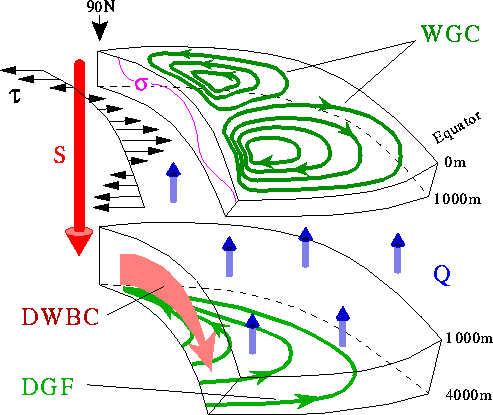
Thomas Stocker, Climate and Environmental Physics, Physics Insitute, University of Bern, Bern, Switzerland
The climate system consists of the five components atmosphere, ocean,
cryophere, biosphere and lithosphere. In order to understand climate
and its changes on timescales from decades to several 100,000 years,
we need to focus on physical and geochemical processes particularly in
the first three components. This chapter gives an introduction to the
ocean component of the climate system. We first discuss the climatic
relevance of the ocean not only as a thermal regulator but also as an
important pacemaker of climate change. The dynamical principles of the
large-scale ocean circulation are presented, and flow regimes relevant
to climatic changes are explained (Fig. 1). We then review results
from models and observations that suggest that the cause for abrupt
climatic changes, which are so abundant in the paleoclimatic record,
is found in the ocean. The physical mechanisms for multiple
equilibrium states of the thermohaline circulation are discussed. The
ocean is also a pacemaker of decadal-to-century time scale
variability. An overview of the evidence for natural variability based
on various proxy data is given and a first attempt at a classification
of mechanisms based on recent modeling results is made.

Figure 1: Schematic view of the different types of circulations in a sectorial ocean basin extending from the equator to the pole with a longitudinal extent of roughly 60o. Wind stress drives a wind driven gyre circulation (WGC) which shows western intensification due to the beta-effect. Wind stress also causes Ekman suction in the northerly and Ekman pumping in the southerly upper layer deflecting a typical near-surface isopycnal sigma. A source of newly formed deep water, S, feeds the deep ocean in which a deep western boundary current (DWBC) develops from which the deep geostrophic flow (DGF) of the interior is derived. DGF flows northward to conserve potential vorticity while slowly upwelling. This results in a mass flux Q that closes the flow. In reality, Q < S in this sector and the DWBC is crossing the equator setting up a global circulation.